| << Chapter < Page | Chapter >> Page > |
Around the geographic North Pole (or magnetic South Pole), Earth’s magnetic field is almost vertical. If an airplane is flying northward in this region, which side of the wing is positively charged and which is negatively charged?
Positive charges on the wings would be to the west, or to the left of the pilot while negative charges would be pulled east or to the right of the pilot. Thus, the left hand tips of the wings would be positive and the right hand tips would be negative.
A wire loop moves translationally (no rotation) in a uniform magnetic field. Is there an emf induced in the loop?
An automobile with a radio antenna 1.0 m long travels at 100.0 km/h in a location where the Earth’s horizontal magnetic field is What is the maximum possible emf induced in the antenna due to this motion?
0.0015 V
The rectangular loop of N turns shown below moves to the right with a constant velocity while leaving the poles of a large electromagnet. (a) Assuming that the magnetic field is uniform between the pole faces and negligible elsewhere, determine the induced emf in the loop. (b) What is the source of work that produces this emf?
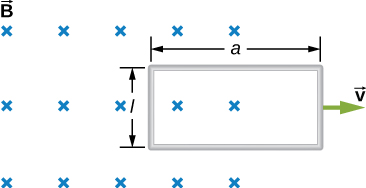
Suppose the magnetic field of the preceding problem oscillates with time according to What then is the emf induced in the loop when its trailing side is a distance d from the right edge of the magnetic field region?
A coil of 1000 turns encloses an area of . It is rotated in 0.010 s from a position where its plane is perpendicular to Earth’s magnetic field to one where its plane is parallel to the field. If the strength of the field is what is the average emf induced in the coil?
In the circuit shown in the accompanying figure, the rod slides along the conducting rails at a constant velocity The velocity is in the same plane as the rails and directed at an angle to them. A uniform magnetic field is directed out of the page. What is the emf induced in the rod?
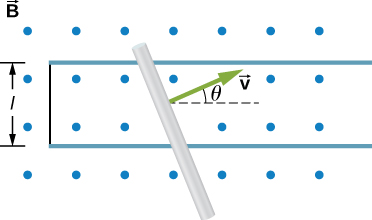
The rod shown in the accompanying figure is moving through a uniform magnetic field of strength with a constant velocity of magnitude What is the potential difference between the ends of the rod? Which end of the rod is at a higher potential?
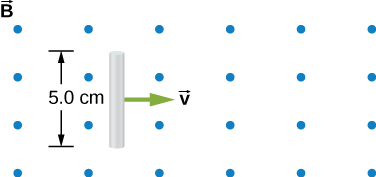
A 25-cm rod moves at 5.0 m/s in a plane perpendicular to a magnetic field of strength 0.25 T. The rod, velocity vector, and magnetic field vector are mutually perpendicular, as indicated in the accompanying figure. Calculate (a) the magnetic force on an electron in the rod, (b) the electric field in the rod, and (c) the potential difference between the ends of the rod. (d) What is the speed of the rod if the potential difference is 1.0 V?
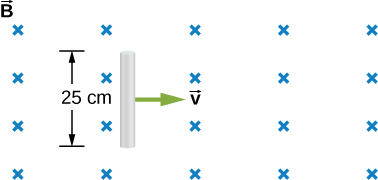
a. ; b. 1.25 V/m; c. 0.3125 V; d. 16 m/s
In the accompanying figure, the rails, connecting end piece, and rod all have a resistance per unit length of The rod moves to the left at If everywhere in the region, what is the current in the circuit (a) when (b) when Specify also the sense of the current flow.
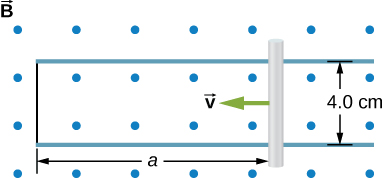
The rod shown below moves to the right on essentially zero-resistance rails at a speed of If everywhere in the region, what is the current through the resistor? Does the current circulate clockwise or counterclockwise?
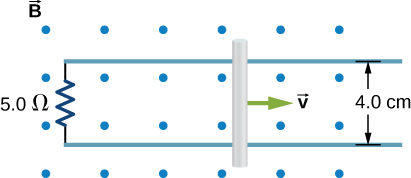
0.018 A, CW as seen in the diagram
Shown below is a conducting rod that slides along metal rails. The apparatus is in a uniform magnetic field of strength 0.25 T, which is directly into the page. The rod is pulled to the right at a constant speed of 5.0 m/s by a force The only significant resistance in the circuit comes from the resistor shown. (a) What is the emf induced in the circuit? (b) What is the induced current? Does it circulate clockwise or counter clockwise? (c) What is the magnitude of ? (d) What are the power output of and the power dissipated in the resistor?
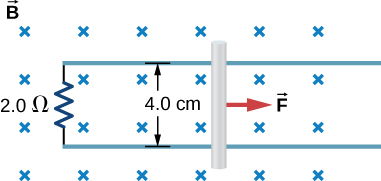

Notification Switch
Would you like to follow the 'University physics volume 2' conversation and receive update notifications?